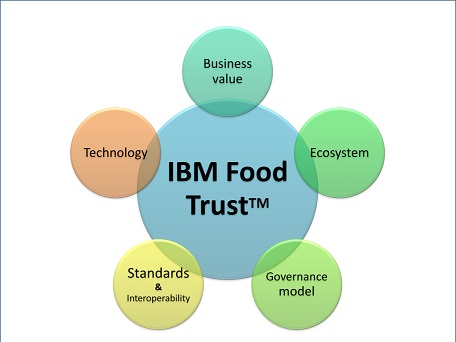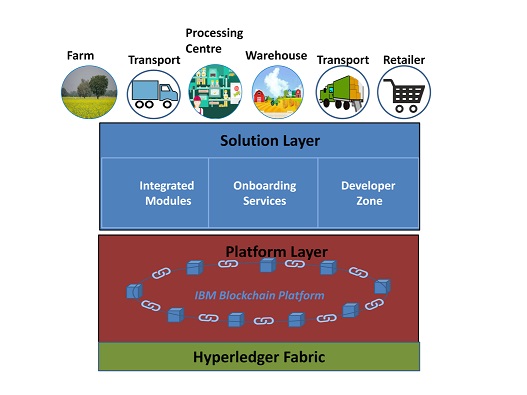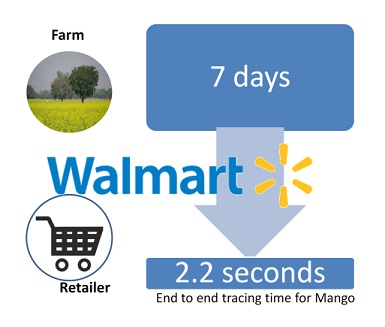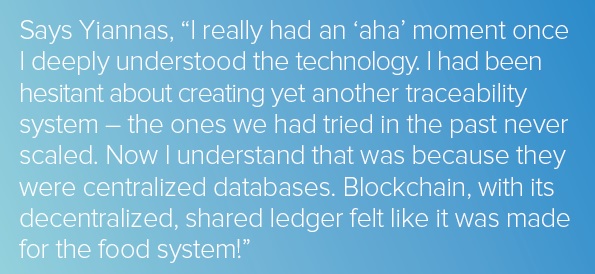Introduction
Traceability System enables tracking of Products. Tracking is one of the features of Traceability System. A traceability system provides information about the product over its life cycle using a system of records. For ex., agricultural produce traceability provides information about the geolocation of the produce, time of the produce, handing over to the market player, processing of the produce, retail store storage, sales info, etc. In Logistics, traceability is about the tracking of goods from pick up to delivery. In a Supply chain, traceability system is expected to identify, track and trace information about the elements of a product as it moves along the supply chain from raw material to finished goods. This could be true of manufacturing of vehicles where lots of parts and assemblies from various sources and suppliers go into the making of the car. Sometimes it is not only important to trace the supplier of the part but also important to identify the batch of the part too.
In a traceability system, the amount of information and the swiftness of information retrieval depends on the system design and implementation. In 2018, Walmart implemented Food Traceability System using Blockchain Technology. The traceability of Mango came down to 2.2 seconds from 7 days; the earlier traceability system at Walmart was requiring 7 days to trace the origin and other details of the product. This is a spectacular performance, no doubt enhances customer services and satisfaction.
Key Traceability Concepts
- Record of information
- Ease of Access to information
- Information flow
- Track & Trace
- Transparency
- Trust
- Monitoring
- Fraud detection and mitigation
- Physical flow
- Life cycle
Why Blockchain for Traceability?
Every business involves a buyer and a seller. Business is done on a value item, increasing the wealth of the economy. Over and above the value of the business, business requires Trust, Security, Integrity, Transparency and Frictionless Transaction. No doubt these characteristics are fundamental to Blockchain technology. DLT and Blockchain are Disruptive Technologies enabling radical innovation in business models and processes.
Benefits of Blockchain-based Traceability Systems
- Increased Transparency as information is traceable. With Blockchain, the traceability can be directly handled by Stakeholder, providing ultimate traceability with transparency and trust.
- Provenance with immutable Blockchain Records goes with Compliance requirement of Regulatory bodies
- Transparency enhances Customer satisfaction; also Value Proposition to Customer and Business
- Reduces risk due to openness amongst stakeholders. It is a kind of Risk Management
- Provides evidence for sustainability claims
- Tracking also adds to the safety of the products and reduces faults in the supply chain, logistics and manufacturing
- In Food traceability systems, safety can be monitored, product isolation is very useful
- Traceability is an important requirement for Quality achievement
- Improved visibility of products and processes
- In case of any defects arising, quick troubleshooting or tracking the history or processes or origin possible.
- Brand image building for the organization due to increased customer satisfaction
- Food Frauds can easily be detected
Use case - Food Traceability System
According to the World Health Organization (WHO), every year 420000 people die and 10% of the population suffers from food illness. Due to this, the cost to the economy, in the USA alone, is 93B$ per year. Therefore it is important to provide access to safe food. Food traceability systems address this issue of identifying the culprit food item and help eliminate from circulation. If information is available and quickly accessible about the supply chain, this defective item elimination can be done selectively to reduce loss to producers, instead of a total ban in such circumstances. Digitising food safety process and product information enables a transparent, trust enhanced, information sharing solution using blockchain technology. Almost every Country has standards and regulations to comply with concerning food safety. Few countries have Traceability as part of standards and guidelines. Better traceability helps in identification and corrective action; therefore saves lives, avoid panic in society and food frauds can be controlled. Not only this, farmers can be protected by the selective elimination of the produce. So we will have a case study on Food Traceability System using Blockchain Technology.
The stakeholders to be part of the system are farmhouses, warehouses, Transporters, Processing houses/industry, Retail stores, and customers. Hence vendor-neutral Opensource blockchain system with interoperabilty is a requirement. Hyperledger was chosen by Walmart for Proof of Concept evaluation. Let us take the case of Mango as farm produce to Mango Juice being sold at retail stores.
The generic sequence of events in Mangos to Mango Juice is as in Table 13.1.
Table 13.1. A Sequence of events from harvesting Mango to Mango Juice sale.
| Location | Activities at this location |
|---|---|
| Mango farm | Harvest Mangoes, Despatch in Vehicle to Processing Plant |
| Processing Plant | Unload Mangoes, Process mangoes to Juice, Quality check, Packaging, Despatch to Retailer Warehouse |
| Retailer Warehouse | Unload, account and redistribute to Retail stores |
| Retail stores | Unloaded, stock updated, displayed for sale |
IBM Food TrustTM
IBM Food TrustTM is comprehensive, a complete and modular Food Traceability System using Hyperledger Fabric for Blockchain technology. It integrates Supply chain solutions with Blockchain functions. Figure 13.2 is a representation of Hyperledeger Blockchain solution for Food Traceability System involving the stakeholders into the system. IBM Food TrustTM is the trademark of WallMart IBM collaborative product. According to IBM, the five pillars of IBM Food TrustTM are Business value, Ecosystem, Governance model, Standards & Interoperabilty and Technology as in figure 13.1.


The best thing about the IBM Food TrustTM is multiple groups including business competitors coexist along with their stakeholders. This is the benefit of Blockchain architecture and Hyperledger fabric framework. The framework gives the plug and play components that are configurable for each business house requirement with the needed Privacy, Security and Integrity. Walmart collaborated IBM Food TrustTM has leading Food supply chain organizations like Nestle, Unilever as members. Competitors, Retailers, Farmhouses, Warehouses, Transporters are all part of the same Traceability system because of the Permissioned blockchain system.
The features of this system are On-boarding services, Integrated Modules for setting the business rules of the system including Chaincode, Access Control, Identity Management etc. One has to create master data in terms of the participating products and locations. The locations are transit points and could be farms, warehouse, retailer, plant, transporter, etc. Products will have the details required for unique identification and any other details desired by the merchandise. Purchase Order, Invoice, Receipts, shipment, shipment notification like e-commerce requirements are also integrated into IBM Food TrustTM. The four modules are Trace ( Tracing the path of a shipment), Fresh Insights ( for optimisation of Inventory), Certificates ( authenticity of process and shipment) and Data entry and access control management.
In the IBM Food TrustTM, the real-world events are mapped and supported by six activities. These are Commission, Decommission, Transformation, Aggregation, Disaggregation and Observation. Commission and Decommission are about creating and deleting an object respectively. Aggregation and disaggregation are synonymous with loading/grouping and unloading/degrouping i.e maybe packaging into large containers and unpackaging to smaller containers in real-world for transporting. Transformation is an irreversible process happening on the product like mango processed into juice. Observation is about stock updation and billing at retail stores.
Bar Codes are used for defining data attributes before uploading to Blockchain as per GS1 Standard. Web based front end interface enables the stakeholders to on-board and interact with the Traceability system. Hyperledger based Food traceability system provides many APIs for customisation including Chaincode. Most of the file uploads use XML for efficiency.
IBM Food TrustTM solution empowers authorized users with immediate access to actionable data. The complete information, from history to the live moment, can be retrieved from IBM Food TrustTM. Typically a participating institution can plan to configure information like origin location of the base produce, product manufacturing location, quality certificate, date of manufacturing, the current location of the product, retail store storage condition details, etc. Transparency with Trust is the purpose of the IBM Food TrustTM solution.
Outcome
Now Walmart traces more than 25 products like Mangoes, strawberry, yoghurt, Pork, Chicken, etc., including greens in their traceability system. The key benefit is the reduced time to trace, almost instantaneous, in seconds. Increased Customer satisfaction and Selective elimination of suspected product are other achievements.



